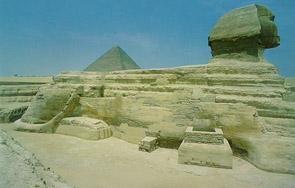|
The
Great Pyramid of Khufu at Giza has a rival for size and grandeur
very close at hand. Standing next to it is the pyramid of
Khufu's successor Khafre, which from many angles looks bigger,
having been built on slightly higher ground. Indeed, the ancient
Egyptians called the Pyramid of Khafre 'The Great Pyramid'
and that of Khufu 'The Pyramid which is the Place of Sunrise
and Sunset'. Although a difference of only a few metres in
height, The Great Pyramid is actually higher, has a shallower
angle of incline than Khafre and encloses a bigger volume.
The Sphinx on the otherhand, stands alone, with no rivals
either on site or elsewhere among all the sphinxes of Egypt.
Truly, this is the Great Sphinx, as well as very likely being
the first of the breed. The Great Sphinx started off as a
knoll of rock (quarried in the course of pyramid building)
at the bottom of the Giza Plateau towards the valley of the
Nile.
The later sphinxes of Egypt were often installed as pairs
to guard entrances to significant places, but the Great Sphinx
of Giza is a one-off. And perhaps the original meaning of
the Great Sphinx was too particular to be shared with another
of its kind.

The damaged face of the Sphinx,
smiling inscrutable smile |
The Sphinx is carved out of the living rock, though parts
of it have been repaired with blocks of stone. It is immediately
apparent that the rock strata of which the Sphinx is made,
varies from a hard grey to a soft yellowish limestone. The
head is made of hard limestone of the same sort as was quarried
around the pyramids. The body on the other hand, is made of
poorly consolidated and therefore readily eroded limestone.
The rock improves again at the base of the monument, with
a return to harder (but brittle) reef-formed limestone that
has allowed some carved details of the beast to remain visible
after at least four-and-a-half thousand years of natural and
human attrition.
In keeping with the whole Giza Plateau, these strata within
the Sphinx run from east to west, in other words from the
breast to the hindquarters, and north to south. The Sphinx
faces due east, with the same great precision of orientation
as is seen in the disposition of the Giza pyramids.

The
heavily eroded Sphinx. |
|
 |
The
monument was made from the start to point directly to sunrise.
Interestingly, the face, excluding the ears is a little awry
in relation to the head as a whole: the left eye is slightly
higher than the right, the mouth off-centre, and the entire
face slightly tilted back.
Despite
the overall better quality stone of the head, the face - as
is immediately apparent - is badly damaged, and not just by
natural erosion. The nose is missing altogether and the eyes
and the areas around them are seriously altered from their
original state, as is the upper lip. Napoleon's artillerymen
have been blamed for using the face of the Sphinx for target
practice.

Fragments
of the Sphinx beard:
casts in the Cairo Museum |
The alteration of the face has brought an insinuation of mood
to the features, which change with the different lights (sometimes
into a knowing smile). This has to be borne in mind when any
attempt is made to compare the face of the Sphinx with the
sculptures of various fourth Dynasty kings.
The head and face of the Sphinx certainly belong to the Old
Kingdom, particularly the fourth Dynasty. The style of the
headdress (known as the 'nemes' head-cloth), with its fold
over the top of the head and its triangular planes behind
the ears, the presence of the royal 'uraeus' cobra on the
brow, the treatment of the eyes and lips all speak of that
historical period.
The sculptures of kings Djedefre, Khafre and Menkaure all
show the same configuration that we see on the Sphinx. Originally,
the Sphinx had a plaited beard seen on many Egyptian statues.
Pieces of the Sphinx's massive beard found during various
excavations adorn the British Museum in London and the Cairo
Museum. The beard was supported by a stone plate to the breast,
parts of which have also been found.
A
hole in the top of the head that is now filled in, indicates
that there was once a head decoration. Depictions of the Sphinx
show a crown or plumes on the top of the head, but these were
not necessarily part of the original design. The top of the
head is flatter, however, than later Egyptian sphinxes. Serious
natural erosion of the body of the Sphinx begins below the
head.
In the 1920s it was considered necessary to support the
head with cement approximations of the absent parts of the
head-dress, and it is these extensions that chiefly account
for the altered appearance of the Sphinx's head in recent
times, when compared with old photographs and drawings.

The
Sphinx temple in front of the Sphinx. |
Erosion below the neck does not look like scouring by wind-blown
sand. In fact, so poor is the rock of the bulk of the body
that it must have been deteriorating since the day it was
carved. And it continues to erode before our very eyes, with
spalls of limestone falling off the body of the Sphinx in
the heat of every day.
|